Army of vandals. ruscists target Ukrainian cultural heritage
 Read in Google News!
Read in Google News! 
Among the war crimes committed by russian occupiers in Ukraine, crimes against cultural heritage play a special part. Destruction of heritage sites, artillery strikes on educational and cultural facilities, looting of museums and archives. The number of recorded episodes and testimonies of employees of the affected facilities prove that these are not isolated cases but a purposeful tactic, ukrinform.net reported.
Historical monuments are in enemy crosshairs because of their will to destroy the Ukrainian identity. Therefore, the aggressor’s actions can be seen as an element of the crime of genocide against the Ukrainian people.
As of early December 2022, the Ministry of Culture and Information Policy has documented the destruction or damage inflicted on more than 1,100 objects of cultural infrastructure. Among them are more than 550 cultural heritage sites. These statistics mostly include monuments of architecture, museums, schools, universities, and culture centers in Donetsk, Mykolaiv, Luhansk, Kharkiv, Sumy, Kherson, Chernihiv, Zaporizhia, and Kyiv regions. Moreover, russians systematically loot museums in the captured territories. “We are probably dealing with the largest looting of museum collections since WWII. However, we are also dealing with the largest evacuation of collections since WWII,” said Minister of Culture and Information Policy Oleksandr Tkachenko.
The Center for Strategic Communication recalls the most outrageous crimes the russian forces have committed against Ukrainian culture.
1. Kharkiv region: destroyed Hryhorii Skovoroda Museum
On the night of May 7, russian artillery struck the museum in the village of Skovorodynivka in the Zolochiv hromada of Kharkiv region. The house of Andrii Kovalivskyi, where the philosopher was staying, was seriously affected by the fire. The destroyed building is not only a museum, but also a monument of architecture of the 18th century.
With a strike on Skovorodynivka, russians in their own manner “congratulated” Ukrainians on the 300-th birthday of the philosopher. It was this museum, on the territory of which the grave of Skovoroda with the legendary inscription “The world tried to catch me but couldn’t” is located, that was given a central role in the celebration of the anniversary. But because of the russian invasion, the event agenda had to be significantly cut.
The enemy failed to destroy the site’s exposition into oblivion. According to the Minister of, the most valuable exhibits had been taken to a safer place in advance.

Miraculously, the surviving monument to Hryhorii Skovoroda, which became a symbol of the invincibility of Ukrainians, was one of the central showpieces of “The World of Skovoroda” exhibition, dedicated to the 300th anniversary of the Ukrainian genius, held at the “Ukrainian House” in Kyiv.
2. Kherson region: ravaged museums
Kherson is the only regional center of Ukraine that the russians managed to capture immediately after the invasion in February 2022. Its liberation clearly demonstrated the future that the invaders were preparing for the occupied territories. Along with mass burials and torture, applied including to children, the Ukrainian forces discovered ravaged and looted museums.
The russians stole the funds of the Oleksii Shovkunenko Kherson Art Museum, Kherson Regional Local Lore Museum, and the Albert Havdzynskyi Art Gallery in Nova Kakhovka.
Collections of iconography of the 17th-20th centuries, Ukrainian paintings of the 19th-20th centuries, in particular, 297 works of painting and graphics by Gavdzynskyi, as well as pieces by modern artists were taken to the occupied Crimea. Some stolen paintings ended up in the exposition of the Central Museum of Tavrida.

Photo: Kherson Art Museum
Here’s the timeline of one of the acts of looting, as per the testimonies of the employees of the Oleksii Shovkunenko Kherson Art Museum: three trucks and a school bus loaded with loot left the territory of the museum in just one day, November 1, 2022. The next day, two more trucks drove off. On November 3, leftovers were picked up by a bus. According to preliminary estimates, this is about 15,000 exhibits.
From the Kherson Regional Local Lore Museum, the occupiers took collections of coins, weapons, Sarmatian decorations of Soviet times and russian Empire, antique furniture of the 18th-19th centuries, a collection of icons, paintings, and the entire part of the exposition with archaeology, which formed the core of the collection.
The regional archive and scientific library named after Oles Honchar also faced a sad fate. The occupiers stole archival documents and collections of pre-revolutionary publications.
3. Mariupol: an airstrike on a local theater and a looted cathedral
During the defense of Mariupol, which lasted almost three months, the besieged city suffered massive destruction. russian invaders methodically destroyed critical utility facilities, civilian homes, as well as social and cultural infrastructure.
The building of the Donetsk Drama Theater, destroyed by an air strike, next to which a huge inscription “Children” had been made in russian for their pilots to be aware of sheltering kids, became one of the symbols of russian war crimes. Most of the children hiding there were killed in the strike, along with their parents.
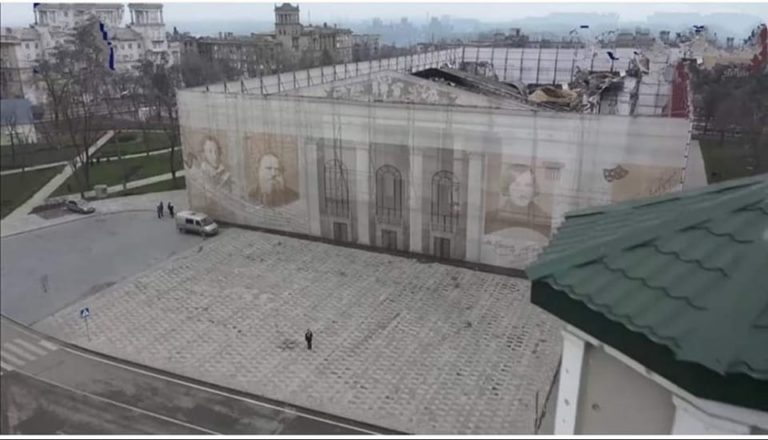
In May, the russians cleared the rubble and buried hundreds of bodies (the exact number of victims has not been established) in unnamed graves in Manhush.
According to local Ukrainian authorities, russian invaders took all valuable exhibits from the Museum of Local Lore and the Kuindzhi Art Museum of Mariupol. The original paintings by Arkhip Kuindzhi and Ivan Aivazovsky have been stolen.
And later, during further hostilities in Mariupol, a museum of local history, an art museum, and an exhibition hall named after Arkhip Kuindzhi were wiped out.
The surviving exhibits, although the “rebuilding of Mariupol” became one of the key topics of russian propaganda, were transported to the occupied Donetsk. Their further fate, in particular, that of the paintings by Ivan Aivazovsky, Tetiana Yablonska, and Mykola Derehus, remains unknown.
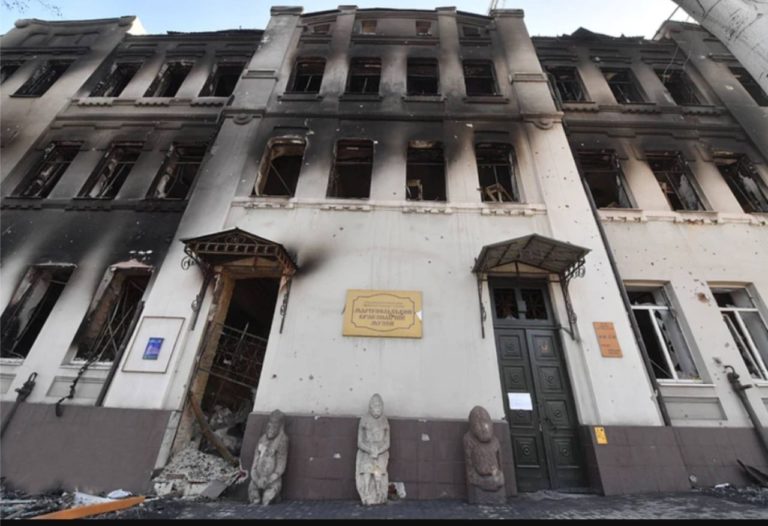
Photo: Mariupol City Council
The Cathedral of St. Petro Mohyla of the Orthodox Church of Ukraine was looted by russian occupiers, and a collection of Ukrainian books was seized and burned in the church backyard. The library contained several unique copies of Ukrainian-language editions, now lost for good.
The Cathedral of St. Peter Mohyla and the Church of the Assumption of Mary of the Orthodox Church of Ukraine in Mariupol are painted with traditional Ukrainian paintings. This is the world’s first church of this size (the total area of the painting is 500 linear meters), painted in the style of “Petrykivka.” The temple is included in the Book of Records of Ukraine.
4. Chernihiv: Tarnovskyi Museum of Antiquities
In March, russian soldiers targeted the house of Vasyl Tarnovskyi in Chernihiv — a monument of architecture of the 19th century. This historic building housed the Museum of Ukrainian Antiquities, founded in 1896, later the Chernihiv Historical Museum, and since 1980 — a youth library. The building and the exhibit of the historical museum were also affected by russian shelling.
5. Trostianets: The Leopold Koenig Garden
The russians destroyed the architectural monument of national significance when retreating from the Sumy region in April — the house of the estate manager Koenig. The garden housed a local history museum, a picture gallery, and a chocolate museum. The main mansion and the most famous part of the garden — the Round Yard — suffered less. The occupiers destroyed a unique library, which contained more than 15,000 books.
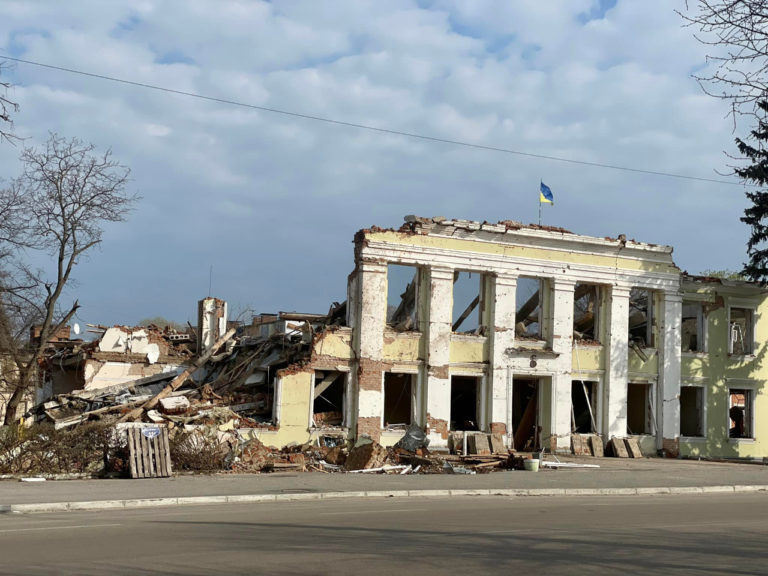
6. Kyiv region: Maria Prymachenko Museum
During the offensive of the russians on Kyiv in February, a museum in Ivankiv was under russian artillery fire, with more than two dozen works of the world-famous artist, representative of “naive art,” Maria Prymachenko, being exhibited there. A part of the collection was already in Kyiv, and part was saved from the burning museum by locals.
7. Donetsk region: wooden skete of the Sviatohirsk Lavra
The All-Saints Skete of the Sviatohirsk Lavra burned down as a result of russian shelling during an enemy offensive in Donetsk region. The All-Saints Skete was built in 1912. This is one of the best examples of inheriting wooden temple architecture. The temple was first destroyed by the Bolsheviks in 1947 and was restored in the early 2000s. It was considered a monument of wooden architecture and was the largest wooden church in Ukraine.
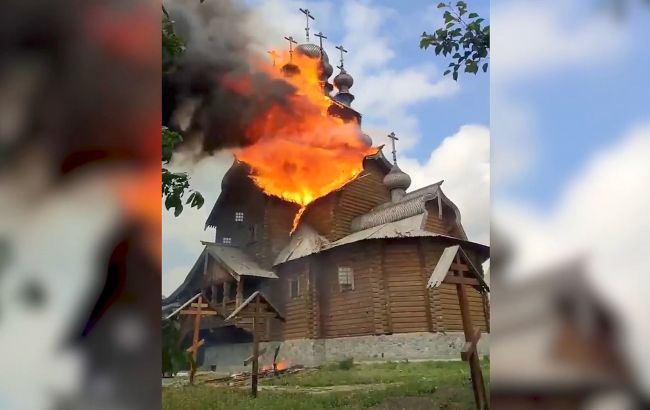
8. Melitopol: looting of Scythian gold
russians robbed the local history museum in the occupied Melitopol of Zaporizhia region. A collection of Scythian, Hun, and Sarmatian gold, silver coins from the Doukhobor treasure, and historical weapons were stolen. The museum staff tried to hide the collection. However, a local collaborator, who was appointed the “director” of the institution, tipped the enemy about the treasures. The fate of the exhibits is currently unknown.
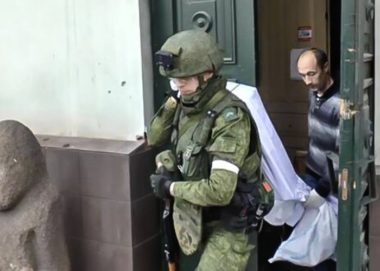
https://platform.twitter.com/embed/Tweet.html?creatorScreenName=ukrinform&dnt=false&embedId=twitter-widget-0&features=eyJ0ZndfdGltZWxpbmVfbGlzdCI6eyJidWNrZXQiOltdLCJ2ZXJzaW9uIjpudWxsfSwidGZ3X2ZvbGxvd2VyX2NvdW50X3N1bnNldCI6eyJidWNrZXQiOnRydWUsInZlcnNpb24iOm51bGx9LCJ0ZndfdHdlZXRfZWRpdF9iYWNrZW5kIjp7ImJ1Y2tldCI6Im9uIiwidmVyc2lvbiI6bnVsbH0sInRmd19yZWZzcmNfc2Vzc2lvbiI6eyJidWNrZXQiOiJvbiIsInZlcnNpb24iOm51bGx9LCJ0ZndfZm9zbnJfc29mdF9pbnRlcnZlbnRpb25zX2VuYWJsZWQiOnsiYnVja2V0Ijoib24iLCJ2ZXJzaW9uIjpudWxsfSwidGZ3X21peGVkX21lZGlhXzE1ODk3Ijp7ImJ1Y2tldCI6InRyZWF0bWVudCIsInZlcnNpb24iOm51bGx9LCJ0ZndfZXhwZXJpbWVudHNfY29va2llX2V4cGlyYXRpb24iOnsiYnVja2V0IjoxMjA5NjAwLCJ2ZXJzaW9uIjpudWxsfSwidGZ3X3Nob3dfYmlyZHdhdGNoX3Bpdm90c19lbmFibGVkIjp7ImJ1Y2tldCI6Im9uIiwidmVyc2lvbiI6bnVsbH0sInRmd19kdXBsaWNhdGVfc2NyaWJlc190b19zZXR0aW5ncyI6eyJidWNrZXQiOiJvbiIsInZlcnNpb24iOm51bGx9LCJ0ZndfdXNlX3Byb2ZpbGVfaW1hZ2Vfc2hhcGVfZW5hYmxlZCI6eyJidWNrZXQiOiJvbiIsInZlcnNpb24iOm51bGx9LCJ0ZndfdmlkZW9faGxzX2R5bmFtaWNfbWFuaWZlc3RzXzE1MDgyIjp7ImJ1Y2tldCI6InRydWVfYml0cmF0ZSIsInZlcnNpb24iOm51bGx9LCJ0ZndfbGVnYWN5X3RpbWVsaW5lX3N1bnNldCI6eyJidWNrZXQiOnRydWUsInZlcnNpb24iOm51bGx9LCJ0ZndfdHdlZXRfZWRpdF9mcm9udGVuZCI6eyJidWNrZXQiOiJvbiIsInZlcnNpb24iOm51bGx9fQ%3D%3D&frame=false&hideCard=false&hideThread=false&id=1579224814480343043&lang=en&origin=https%3A%2F%2Fwww.ukrinform.net%2Frubric-ato%2F3641428-army-of-vandals-and-looters-russians-targeting-ukrainian-cultural-heritage.html&sessionId=7b2af63e60faeeee980a8c26088e5ae007d59cc2&siteScreenName=ukrinform&theme=light&widgetsVersion=2615f7e52b7e0%3A1702314776716&width=550px
9. Kharkiv: historical buildings in the city center
On March 1, during the battle for Kharkiv, russians fired two Kalibr missiles at the building of the regional state administration and regional council. Twenty-nine people were killed by the strike.
In two weeks, a missile attack destroyed a neighboring residential block — a local architectural monument.
The Palace of Labor (previously owned by insurance company “russia”), one of the architectural sights of Kharkiv, was struck by a hostile missile on March 2. The roof collapsed, the windows were shattered, and walls were damaged. During shelling, the facades of the city council building and the 18th-century Dormition Cathedral, located nearby, were also affected.
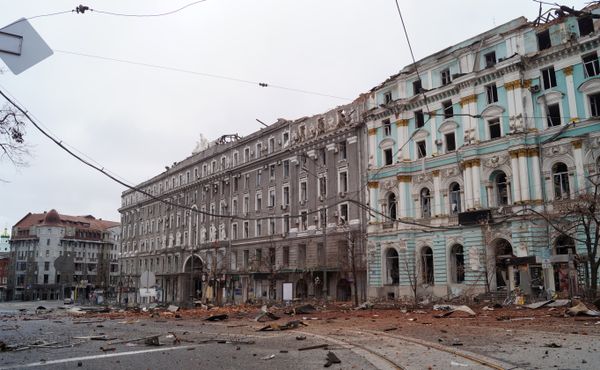
On March 29, an enemy missile hit an old fire station on the Poltava Way. It was built in 1887 and the fire tower — 40 years earlier. It had long been the tallest building in Kharkiv, and until recently towered over the low-rise development of Zalopan.
The highest number of the destroyed architectural monuments in Kharkiv is in the central part of the city.
In total, russian occupiers destroyed and damaged more than a hundred architectural monuments in Kharkiv and the surrounding area.
10. Zhytomyr region: Church of the Nativity of the Blessed Virgin Mary
This is another architectural monument of national importance destroyed by russian occupiers. Built in 1862, the wooden temple survived two world wars, only to be engulfed in flames following a russian artillery attack in early March.
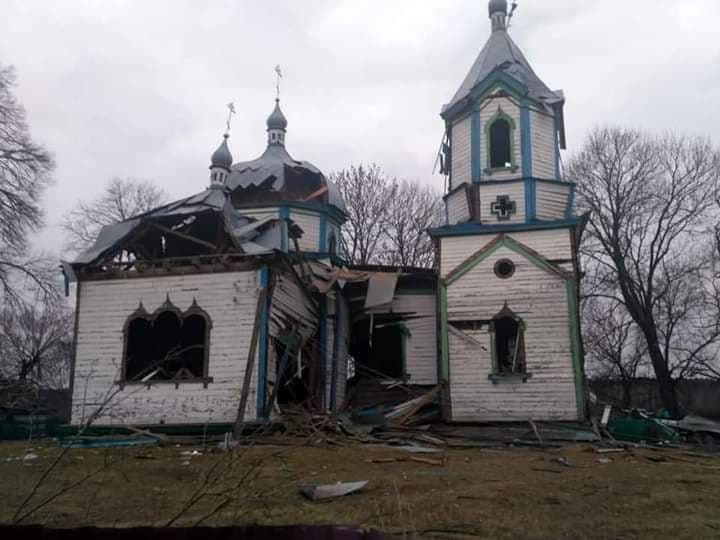
11. Zaporizhia region: Kamyana Mohyla (Stone Tomb)
Back in late April, the russian military mined the territory near the Kamyana Mohyla, a unique monument of geology and archaeology of world importance, located in the Zaporizhia region near Melitopol. The Kamyana Mohyla Monument is a cult complex, the only site in all Eastern Europe where cave paintings from the late Palaeolithic to the Middle Ages have been preserved. The hill counts about 3,000 slabs, under which there are 65 grottoes and caves, richly covered with petroglyphs. Since 2006, the Kamyana Mohyla archaeological complex has been on the preliminary UNESCO World Heritage List, claiming the right to be included in the main UNESCO World Heritage List.
12. Crimea: Bakhchisaray Khan’s Palace
The russians are dismantling the roof and the ensemble of colored stained-glass windows of the Golden Cabinet, replacing the ancient roof with modern cover, that is, erasing the national memory. The so-called “restoration” of the Khan Palace began in 2016. It is an act of vandalism and abuse of history of the people, which, despite colossal pressure, repression, and other forms of aggression, demonstrates to the world the commitment to the principles of democracy, territorial integrity of Ukraine, human rights, and the will to achieve freedom by non-violent methods.
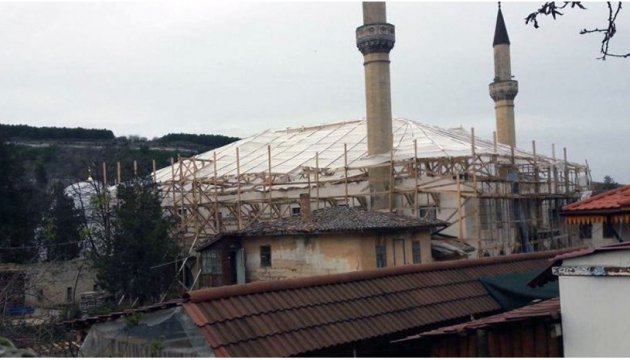
The palace in Bakhchisaray is a unique Crimean Tatar architectural monument, which is evidence of the existence, development, and ethnogenesis of Crimean Tatars in this territory.
***
russian aggression has shown that the kremlin is trying to destroy not only Ukrainian statehood, but also Ukrainian identity. The war against cultural heritage is part of this effort. The russians practice scorched earth tactics, not caring about possible victims and destruction, as well as carry out terrorist attacks on civilian objects. Among them, especially at the onset of the invasion, were many cultural monuments. War inflicts enormous damage on archaeological heritage: entire cultural layers can be destroyed amid hostilities.
russians treat cultural heritage as colonizers, destroying what they cannot use in their own interests, in particular, to promote their own vision of a “great russian culture.”
For Ukrainian monuments, they have a limited list of scenarios:
● clearing the cultural field to replace it with their own and to claim that there was “nothing” there before/without russia;
● appropriating someone else’s cultural heritage to then impersonate it as their own. To this end, the occupiers loot Ukrainian museums; and
● appropriating assets for the purpose of enrichment.
Such practices have been traditional for russia for over 100 years. The lion’s share of expositions of russian central museums falls on archaeological finds from Ukraine, samples of Ukrainian iconography, secular paintings, and other monuments of Ukrainian culture, with the Cossack hetmans’ regalia inclusive. All this is exhibited as “russian” art.
Ukraine today has the right to raise the issue of compensation for damages in the cultural sphere, applying both general and special provisions of international law: UNESCO conventions, UN General Assembly resolutions, the 1970 Convention on the Means of Prohibiting and Preventing the Illicit Import, Export and Transfer of Ownership of Cultural Property, the 1972 Convention Concerning the Protection of the World Cultural and Natural Heritage, etc. The key instrument of reparation is restitution — the return of stolen values and restoration of the integral cultural heritage by replacing the affected valuables with similar ones.
Already today, the Ministry of Culture is documenting crimes to further work in the legal field and bring russia to justice. It also created a platform for the restoration of cultural monuments that suffered from russian aggression.
Center for Strategic Communication and Information Security

